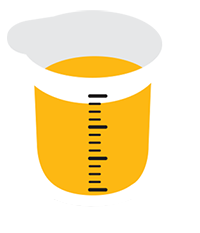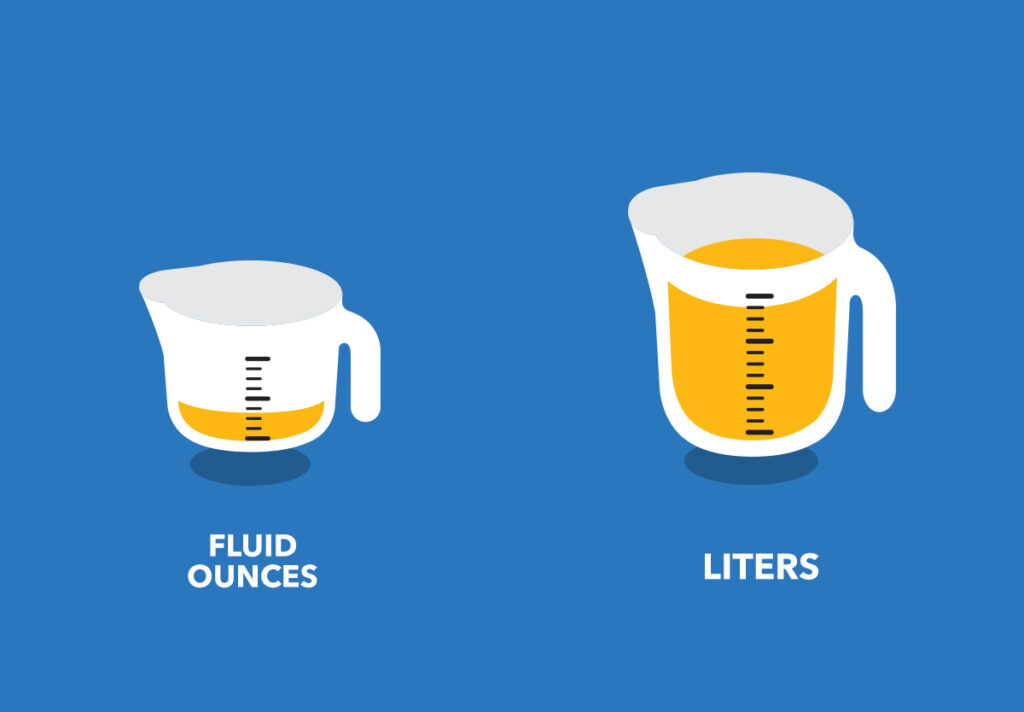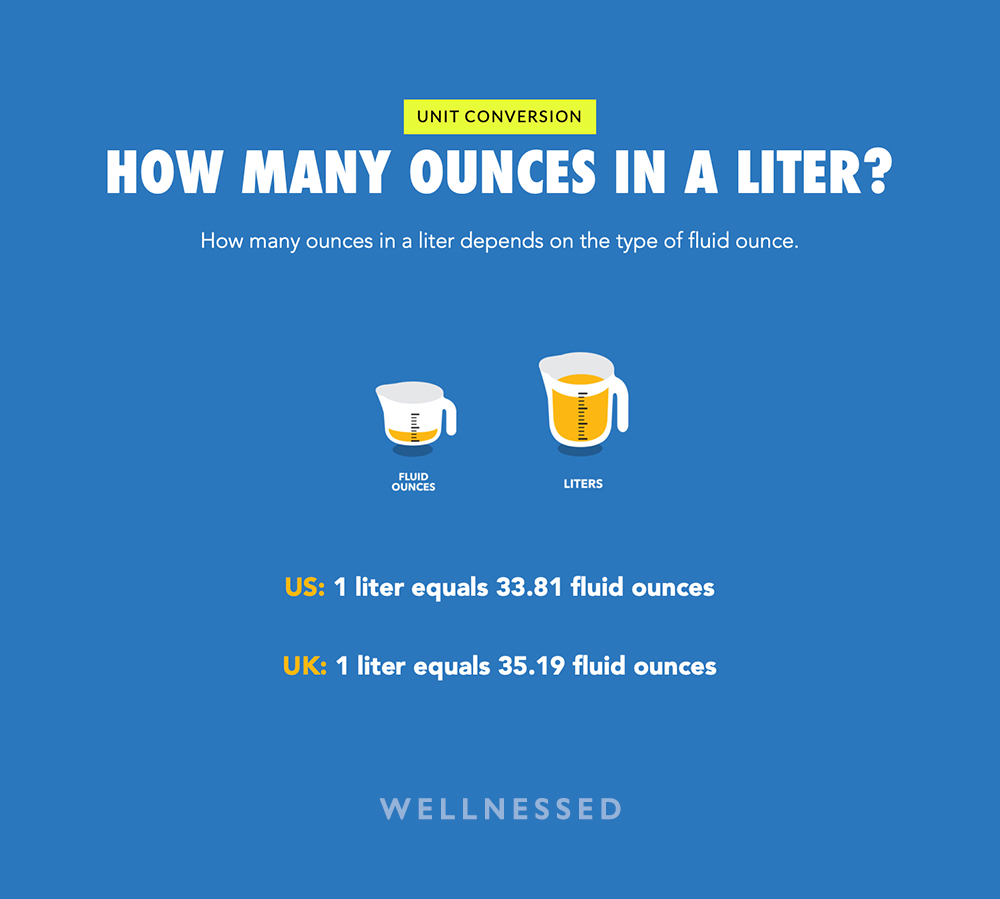One liter is equivalent 33.81 fluid ounces in the United States (US). Ounces and liters are from of two different systems of measurement. Ounces are part of the traditional US and British measurement systems, while liters are part of the newer metric system.
Liter & Ounces Converter

Calculate how many ounces are in a liter (or vice versa) with this conversion calculator. Enter the amount, select which conversion you want, and then click convert.
The United States mostly uses the US system of measure, though most food packaging also includes metric units on the label. However, much of the world has adopted the metric system, which means that converting between ounces and liters is becoming increasingly necessary.
What is An Ounce?
There are several types of ounces, measuring weight or volume:
- Ounce (also called dry ounce or avoirdupois ounce) measures weight. It is abbreviated as oz. The best way to measure ounces is with a scale.
- Fluid ounce measures volume. It is abbreviated as fl oz. The best way to measure fluid ounces is with a measuring jug.
Dry ounces and fluid ounces are not interchangeable.
Ounces originate from the Ancient Roman unit unica, which was one-twelfth part of a Roman pound. Ounces found their way to France in the 12th century when the French adopted a unit called the once or unce, and by the 14th century the ounce had established itself in England. The abbreviation oz. derives from an Italian unit of measurement used in the 14th century called onza, which was used to indicate “a small quantity”.
Ounces are used in the US customary system (the system of measurement in the United States) and the imperial system of measurement (the system of measurement from the United Kingdom). While both systems have ounces, they are not the same size.
This means there are several types of fluid ounces. So the number of ounces in a liter will vary depending on the type of fluid ounce.
Types of Fluid Ounces
- US customary fluid ounce. One fluid ounce is 29.57 mL. Used in the United States.
- Imperial fluid ounce. One ounce is 28.41 mL. Used in the United Kingdom (UK) and many English-speaking countries that share historical ties with the UK, such as Canada and Australia. An imperial fluid ounce is slightly smaller than a US ounce – about 4% less.
If you’re following a recipe that is using ounces and other non-metric volume measurements (e.g. pints, quarts, and gallons), it’s important to know whether the recipe is referring to the U.S. system or the imperial system of measurements. And whatever you do, don’t get your ounces confused with your snow leopards (also called ounces).
What is a Liter?
The liter (international spelling litre), is a unit of volume from the metric system that was created by the French in the 1790s, during the French Revolution. The French proposed the idea of a uniform measure to the British and Americans at the time, but were rejected. Instead the British adopted the imperial system of measures and the United States retained their system – and that’s why we need conversion charts today.
From 1901 to 1968, one liter was equivalent to the volume of 1 kg of pure water at 4°C (39°F). Today, one liter is defined as being equal to one cubic decimeter or one thousandth of a cubic meter. Not quite as visual a definition, but apparently more accurate.
The abbreviation for liter is l, L, or ℓ. The word liter derives from an older French unit of measurement called the litron, which originally came from the ancient Greek litra (a monetary unit at the time). But what’s in a name? Initially the French had settled on calling their new unit of measurement the cadil before opting for the litre.
Unit Conversion
How Many Ounces in A Liter?
How many ounces in a liter depends on the type of fluid ounce.

US: 1 liter equals 33.81 fluid ounces
UK: 1 liter equals 35.19 fluid ounces
That’s a whole bunch of theory. So to make things a lot easier, you’ll find ounces and liters conversion charts below.
The numbers are rounded to the nearest 2 decimal numbers for the conversion into liters and rounded to a whole numbers for the conversion into milliliters.
US Fluid Ounces to Liters
This chart converts US customary fluid ounces to liters and millimeters.
| Fluid ounces (US) | Liters | Milliliters |
|---|---|---|
| 1 fl oz | 0.03 l | 30 ml |
| 2 fl oz | 0.06 l | 59 ml |
| 4 fl oz | 0.12 l | 119 ml |
| 6 fl oz | 0.18 l | 177 ml |
| 8 fl oz | 0.24 l | 237 ml |
| 10 fl oz | 0.30 l | 296 ml |
| 16 fl oz | 0.47 l | 473 ml |
| 20 fl oz | 0.59 l | 591 ml |
| 25 fl oz | 0.74 l | 739 ml |
| 30 fl oz | 0.89 l | 887 ml |
| 32 fl oz | 0.95 l | 946 ml |
| 64 fl oz | 1.89 l | 1893 ml |
| 96 fl oz | 2.84 l | 2839 ml |
| 128 fl oz | 3.79 l | 3785 ml |
UK Fluid Ounces to Liters
This chart converts UK imperial fluid ounces to liters and millimeters.
| Fluid ounces (UK) | Liters | Milliliters |
|---|---|---|
| 1 fl oz | 0.03 l | 28 ml |
| 2 fl oz | 0.06 l | 56 ml |
| 4 fl oz | 0.13 l | 113 ml |
| 6 fl oz | 0.17 l | 170 ml |
| 8 fl oz | 0.23 l | 227 ml |
| 10 fl oz | 0.28 l | 284 ml |
| 16 fl oz | 0.45 l | 455 ml |
| 20 fl oz | 0.57 l | 568 ml |
| 32 fl oz | 0.91 l | 909 ml |
| 64 fl oz | 1.82 l | 1818 ml |
| 96 fl oz | 2.73 l | 2727 ml |
| 128 fl oz | 3.64 l | 3636 ml |
Liters to Fluid Ounces (US)
This chart converts liters (and millimeters) to US customary fluid ounces.
| Liters | Milliliters | Fluid Ounces (US) |
|---|---|---|
| 0.01 l | 10 ml | 0.3 fl oz |
| 0.03 l | 30 ml | 1.0 fl oz |
| 0.05 l | 50 ml | 1.7 fl oz |
| 0.1 l | 100 ml | 3.4 fl oz |
| 0.2 l | 200 ml | 6.8 fl oz |
| 0.25 l | 250 ml | 8.5 fl oz |
| 0.4 l | 400 ml | 13.5 fl oz |
| 0.5 l | 500 ml | 16.9 fl oz |
| 0.75 l | 750 ml | 25.4 fl oz |
| 1 l | 1000 ml | 33.8 fl oz |
| 2 l | 2000 ml | 67.6 fl oz |
| 4 l | 4000 ml | 135.3 fl oz |
| 5 l | 5000 ml | 169.1 fl oz |
| 10 l | 10000 ml | 338.1 fl oz |
| 20 l | 20000 ml | 676.3 fl oz |
Liters to Fluid Ounces (UK)
This chart converts liters (and millimeters) to UK imperial fluid ounces.
| Liters | Milliliters | Fluid Ounces (UK) |
|---|---|---|
| 0.01 l | 10 ml | 0.34 fl oz |
| 0.03 l | 30 ml | 1.26 fl oz |
| 0.05 l | 50 ml | 1.8 fl oz |
| 0.1 l | 100 ml | 3.5 fl oz |
| 0.2 l | 200 ml | 7.08 fl oz |
| 0.25 l | 250 ml | 8.8 fl oz |
| 0.4 l | 400 ml | 14.1 fl oz |
| 0.5 l | 500 ml | 17.6 fl oz |
| 0.75 l | 750 ml | 26.4 fl oz |
| 1 l | 1000 ml | 35.2 fl oz |
| 2 l | 2000 ml | 70.4 fl oz |
| 4 l | 4000 ml | 140.8 fl oz |
| 5 l | 5000 ml | 176.0 fl oz |
| 10 l | 10000 ml | 352.0 fl oz |
| 20 l | 20000 ml | 703.9 fl oz |


